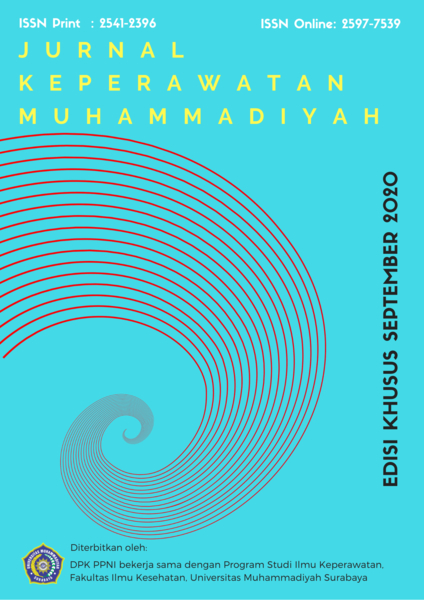Hubungan Karakteristik Mahasiswa Dengan Kecenderungan Perilaku Cyberbullying
DOI:
https://doi.org/10.30651/jkm.v0i0.5578Keywords:
tipe kepribadian, kontrol diri, cyberbullyingAbstract
The development of Information Technology (IT) in the community is very rapid and able to change human lifestyles to meet information needs. Nowadays, information can spread very quickly and be difficult to control which causes an increase in the use of IT, especially social media. This has led to bullying behavior through  social media (cyberbullying), especially among adolescents who have a negative impact and influence on behavior such as the personality and self-control.
Objective:To determine the correlation between students' characteristics (personality and self-control) and the tendency of cyberbullying behavior in the Faculty of Health Sciences UMP.
Method:Â This is a quantitative correlational study with a cross-sectional approach. The population is 43 students who were the cyberbullying perpetrators at the Faculty of Health Sciences UMP. The sampling technique was total sampling; it selected 43 students. The researchers used univariate and bivariate analysis.
Results:Â It shows that more respondents are women or 34 people (79.1%) than men who are only 9 people (20.9%). The respondents who have introverted personality types are 19 people (44.2%) and 24 people (55.8%) are extroverted. The ability of self-control is mostly moderate, it shows 18 people are moderate (41.9%), 10 people (23.3%) are very low and 1 person (2.3%) is very high. Based on the Sig. (2-tailed) between personality type (X1) and cyberbullying behavior (Y) it showed a score of 0.035 0.05, and between quality control (X2) and cyberbullying behavior (Y) the score of 0.009 0.05 was obtained, so that it could be concluded that there is a correlation between the characteristics of students and the tendency of cyberbullying behavior.
Conclusion:Â Most of the students were in extrovert personality types (55%) and the quality of self-control was in the moderate category (41.9%).
Â
Â
References
Afdol et al (2005). Latar Belakang Sosial Ekonimi Dan Tingkat Kepuasan Hidup Lanjut Usia Penghuni Panti Werdha. PPKP Lemlit Unair Surabaya.
Alwisol (2014). Psikologi Kepribadian. Cetakan XII. Universitas Muhammadyah Malang. Malang.
Arikunto, S. (2010). Prosedur Penelitian : Suatu Pendekatan Praktik. Rineka Cipta. Jakarta.
Atkinson, Rita. 1997. Pengantar Psikologi. Jakarta: Erlangga Chandra B. (2008). Metodologi Penelitian Kesehatan.EGC Jakarta.
Budiarto E, (2010). Biostatistik Untuk Kedokteran dan Kesehatan Masyarakat. EGC Jakarta
Beran, T. dan Li, Q. (2007). The Relationship between Cyberbullying and School Bullying. Journal of Student Wellbeing, Vol. 1(2), 15-33.
Fitri, Nuzulul (2012). Hubungan Tipe Kepribadian Dengan Tingkat Kepuasan Hidup Lansia Studi Di UPT Pelayanan Sosial Lanjut Usia Pasuruan Babat. Skripsi (Perpustakaan Sekolah Tinggi Ilmu Kesehatan Insan Cendekia Medika Jombang).
Goleman (2005). Emotional Intelegence. Jakarta : PT. Gramedia Pustaka Utama
Hidayat, A. Aziz Alimul (2007). Metode Penelitian Keperawatan Dan Teknik Analisa Data. Penerbit Salemba Medika. Jakarta.
Hurlock E.B (2005). Psikologi Perkembangan Suatu Pendekatan Sepanjang Rentang Kehidupan Edisi 5. Penerbit Erlangga. Jakarta.
Iskandar Y (2005). Test personality. Yayasan Dharma Graha. Jakarta.
Jamil, Mokhtar (2012). Kepuasan Interaksi Sosial Lansia Denga Tipe Kepribadian. Universitas Muhammadiyah Malang. Diakses pada tanggal 21 februari 2017 di http://ejournal.umm.ac.id/index.php/keperawatan/article/view/2594
Kartono Kartini (2006). Psikologi Umum. Mandar Maju. Bandung.
Kurniantaka L. Dwi (2016). Hubungan Dukungan Keluarga Dengan Kualitas Hidup Lansia Yang Mengalami Penyakt Kronis Di Posyandu Lansia Desa Klecorejo Mejayan Madiun. Skripsi (Perpustakaan Sekolah Tinggi Ilmu Kesehatan Insan Cendekia Medika Jombang).
Kowalski, R. M. (2012). Cyberbullying : In The Digital Age. USA : Blachwell Publishing.
Mubarak W. Iqbal (2009). Sosiologi Untuk Keperawatan (Pengantar & Teori). Penerbit Salemba. Jakarta.
Notoatmodjo, Soekidjo (2010). Metodologi Penelitian Kesehatan. Edisi Revisi Cetakan I. PT Rineka Cipta. Jakarta.
Notoatmodjo, Soekidjo (2012). Metodologi Penelitian Kesehatan. Edisi Revisi Cetakan II. PT Rineka Cipta. Jakarta.
Nugroho W (2008). Keperawatan Gerontik. EGC. Jakarta.
Nursalam (2016). Metodologi Penelitian Ilmu Keperawatan; Pendekatan Praktis Edisi 4. Salemba Medika. Jakarta.
Nursalam. (2008). Konsep Dan Penerapan Metodologi Penelitian Ilmu keperawatan Edisi 2. Salemba Medika. Jakarta.
Nursalam. (2003). Konsep Dan Penerapan Metodologi Penelitian Ilmu keperawatan. Salemba Medika. Jakarta.
Padila (2013). Buku Ajar Keperawatan Gerontik. Nuha Medika. Yogyakarta.
Papalia, D, E. Old, S. W., Feldmen. (2008). Human Developmen (terjemahan A.K. Anwar). Jakarta : Prenada Media Group
Patchin, J. W., dan Hinduja, S. (2010). Cyberbullying and Self-Esteem. Journal of School Health, Vol. 80, No. 12, 23-30.
Rifaudin, M. (2016). Fenomena cyberbullying pada remaja. Jurnal Ilmu Perpustakaan, Informasi, dan Kearsipan Khizanah Al-Hikmah, Vol. 4, 35-34.
Riyanto, Agus (2013). Statistik Deskriptif Untuk Kesehatan. Nuha Medika. Yogyakarta.
Saryono (2010). Kumpulan Instrument Penelitian Kesehatan. Nuha Medika. Yogyakarta.
Saryono (2013). Metodologi Penelitian Kualitatif Dan Kuantitatif Dalam Bidang Kesehatan. Nuha Medika. Yogyakarta.
Setiadi (2007). Konsep & Penulisan Riset Keperawatan. Graha Ilmu. Yogyakarta.
Sobur Alex (2011). Psikologi Umum Dalam Lintas Sejarah. Cv Pustaka Setia. Bandung.
Sugiyono. (2007). Statistika Untuk Penelitian. Bandung: Alfabeta
Sugiyono. (2011). Metode Penelitian Pendidikan (Pendekatan Kuantitatif, Kualitatif, dan R & D). Bandung : Alfabeta
Sugiyono. (2013). Metode Penelitian (Pendekatan Kuantitatif, Kualitatif, dan R & D). Bandung : Alfabeta
Wade, L. G., dan Tavris. (2008). Organic Chemistrty. Sixth edition. New Jersey : Pearson Education Internasional.
William, A. (2012). Buku Saku Hitam Kedokteran Internasional. Penerjemah Risqi A. Jakarta : Permata Puri Media.
Wong. D, dkk. 2009. Buku Ajar Keperawatan. Volume 1. Jakarta : EGC
Yusuf, S. dan Nurihsan. (2015). Psikologi Perkembangan Anak dan Remaja. Bandung : PT. Remaja Rosdakarya
Downloads
Published
Issue
Section
License
- Penulis tetap memegang hak atas karyanya dan memberikan hak publikasi pertama kepada jurnal ini yang secara simultan karya tersebut dilisensikan di bawah:Â Creative Commons Attribution-ShareAlike 4.0 International (CC BY-SA 4.0)









